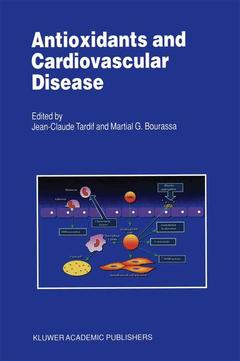Description
Antioxidants and Cardiovascular Disease, Softcover reprint of the original 1st ed. 2000
Developments in Cardiovascular Medicine Series, Vol. 233
Coordinators: Tardif J.C., Bourassa Martial G.
Language: English
Subjects for Antioxidants and Cardiovascular Disease:
Antioxidants and Cardiovascular Disease
Publication date: 10-2012
258 p. · 16x24 cm · Paperback
Publication date: 10-2012
258 p. · 16x24 cm · Paperback
Antioxidants and cardiovascular medicine
Publication date: 09-2000
264 p.
Publication date: 09-2000
264 p.
Description
/li>Contents
/li>
Generation of oxidants or reactive oxygen species is a natural process of human biology. Mitochondrial respiration, phagocytic activity and cyclooxygenase activation are all essential processes of life, which also generate oxidative species. In humans, chronic oxidative stress often coupled with deficiency of antioxidant defenses is associated with the aging process and can lead to the development of disorders such as cancer and arterial disease. Major cardiovascular conditions in which oxidative damage has been strongly implicated include atherosclerosis, myocardial ischemia and reperfusion, coronary restenosis and congestive heart failure. Compelling evidence points to oxidative stress as an important trigger in the complex chain of events leading to atherosclerosis. The expression of chemotactic factors and adhesion molecules is modified by oxidative stress. Exposure to superoxide ions activates the NF-kappa B regulatory complex and triggers the transcription of several atherosclerosis related genes. These events lead to the accumulation of macrophages in the arterial wall. Macrophages avidly incorporate oxidized low-density lipoproteins (LDL) to form foam cells. The activity of matrix metalloproteinases is also regulated by oxidative stress. This activity appears to be closely coupled with smooth muscle cell activation and migration. Matrix metalloproteinases have also been implicated in the pathophysiology of plaque rupture. Antioxidant supplementation including vitamin E decreases susceptibility ofLDL to oxidation and retards the progression of atherosclerosis in animal models.
List of Contributors. Preface by the editors. 1. Lipoproteins and Oxidation: Clinical Aspects of Lipoprotein Metabolism and Oxidation; H.R. Superko. 2. Pathogenesis of Artherosclerosis; R. Gallo, V. Fuster. 3. The Antioxidant Hypothesis; M. Forgione, J. Loscalzo. 4. Reactive Oxygen Species as Mediators of Signal Transduction in Cardiovascular Disease; J. Abe, B.C. Berk. 5. Pharmaceutical Compounds with Antioxidant Activity; A. Bast, G.R.M.M. Haenen. 6. Nutrition and Antioxidants; P. Rubba, M. Mancini. 7. Antioxidants and Vascular Disease: Animal Studies; J.F. Keaney, Jr. 8. Antioxidants and Endothelial Function - Human Studies; C. Bingelli, et al. 9. Antioxidant Vitamins and Cardiovascular Disease: Evidence from Observational Epidemiologic Studies and Randomized Trials; W.G. Christen, C.H. Hennekens. 10. A Rationale for Antioxidant Use in Cardiovascular Disease; R.P. Mason. 11. Antioxidants and Restenosis - Animal Studies; A. Lafont, et al. 12. Antioxidants and Restenosis - Human Studies; J.-C. Tardif, et al. 13. Role of Oxidative Stress, Cytokines and Apoptosis in Myocardial Dysfunction; D.B. Sawyer, W.S. Colucci. 14. Oxidative Stress and Use of Antioxidants in Patients with Congestive Heart Failure; M. White, et al. 15. Use of Antioxidants in Cardiovascular Medicine; J.L. Mehta, et al. Appendix. Update on Recently Completed Clinical Trials on Antioxidants and Cardiovascular Diseases; J.-C. Tardif, M.G. Bourassa. Index.
© 2024 LAVOISIER S.A.S.




